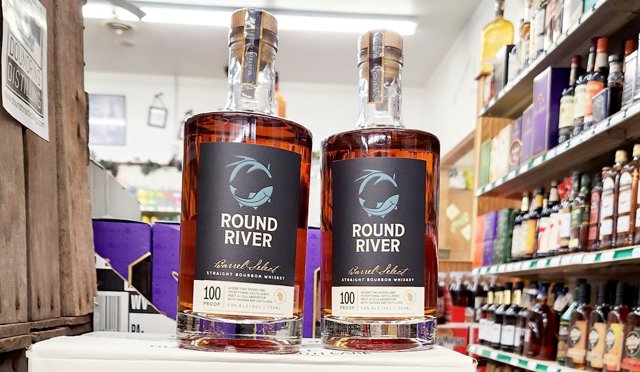CRAWFORD COUNTY - Crawford County businessman Dan Johnson recently launched his Round River brand of distilled Bourbon whiskey. The limited run bottling is currently available at local retailers such as Kickapoo Kwik Stop in Readstown, Viroqua Food Co-op, and the Driftless Café, with more retail outlets coming.


Johnson has been pursuing the project since he first moved to his farm in Utica Township on Johnstown Road in Crawford County 20 years ago.
“I have been wanting to pursue a value-added farm product since I moved to the Driftless Region 20 years ago from Colorado,” Johnson told the Independent-Scout. “In Colorado, and here in Crawford County with Driftless Homewrights, I have a long career in natural building, but I wanted to pursue a livelihood that involved conservation on the farm.”
Johnson explained that the common theme in all the businesses ventures he has pursued in his life involve goals of sustainability and conservation
The brand name, ‘Round River,’ comes from an Aldo Leopold essay in his Sand County Almanac by the same name. In Leopld’s essay, the Round River was a fabled Wisconsin river, described in folktales, which was said to flow in a circle. Leopold explains that this was a parable, and the state of Wisconsin is itself a round river, a loop of energy, a circle of life.
“Round River Distilling is a company committed to premium spirits crafted from the grains and waters of Wisconsin’s Driftless Region,” Johnson said.
Johnson has a property that he plans to develop into a distilling operation on Main Street in Viroqua, and has pursued grant funding and investment to help bring that vision to fruition. He currently has charred oak barrels of his product aging under the contracted supervision of 45th Parallel Disillery, a New Richmond, Wisc., company.’
“Our current product that we’re bringing to market under the Round River brand mark is a blend of two barrels, one produced by 45th Parallel and the other by Yahara Bay distilleries. The two barrels were selected after extensive taste testing,” Johnson said. “Our own product won’t be ready for bottling for several years.”
Karyl Fritsche, USDA-NRCS Resource Conservationist for Crawford County reports she is eager to offer Johnson’s bourbon at her new Drake Piano Bar business in Prairie du Chien. Fritsche says Johnson’s venture fits well with her initiative to develop a market for small grains grown in the Driftless Region.
“Through the aerial cover crop program, we’ve achieved scale in the planting of small grains in our region,” Fritsche said. “Now we need to refine how those grains are grown to achieve a distilling grade crop, and start to create a strong market to make growing small grains profitable for our farmers.”
Bourbon v. Whiskey
Johnson discussed the definitions of ‘bourbon’ and ‘whiskey,’ and the differences in the two appelations.
“Bourbon is the result of a ‘mashbill’ or recipe that requires it to be made from a minimum of 51 percent corn, with the rest of the mash filled out with small grains such as rye or wheat, and malted barley,”Johnson explained. “It is also required that it be aged in charred oak barrels, made from oak trees in the U.S.”
The corn we are using is a heritage type known as ‘Bloody Butcher,’ grown organically by Utica Township farmer Josh Engels of Driftless Organics.
“Josh has been an enthusiastic partner with us in growing the grains we need to pursue our Round River Distilling brand,” Johnson reported. “He took a leap three-to-four years ago, and started growing the corn and other small grains that we’ve used in our first mash.”


The process
Johnson explained that the big bourbon whisky manufacturers are almost always bringing blends to market in order to standardize their product offerings.
“That’s not the market niche we’re pursuing - rather we emphasize a ‘barrel select series,’ where every bottling could be slightly unique,” Johnson said. “It’s a form of niche marketing that some distillers are pursuing, and we’re not really trying to compete with the big brands.”
Johnson said that after the fermentation process, the product that emerges is essentially beer, with an average eight percent alcohol.
“The ‘beer’ is the result of the mashing/cooking and fermentation,” Johnson said. “It is then distilled, which separates and concentrates the alcohol and associated flavors to create the ‘spirit’ or what is basically moonshine that is aged in the barrel.”
Johnson explained that a distiller could start with two bourbons made from identical mashbills, but emerge with a subtly different product after aging due to a variety of factors.
“The location, high or low, in the warehouse. often called a ‘rickhouse or rackhouse’ can make a big difference due to temperature variations,” Johnson explained. “The differences in temperature can affect the ‘angel share,’ or the amount of product that evaporates in the process of aging.”
“Distillation is the process of separating liquids by their boiling point,” Johnson explained. “Alcohol has a lower boiling point than water, so the alcohol will vaporize at about 173 degrees, and water at about 212 degrees.”
By this means, the alcohol is ‘distilled’ out of the total yield, and this is the bourbon that will ultimately be bottled.
Other distillations
Johnson made clear that bourbon whiskey is just the beginning for his product line, and that he will likely move on to produce other ‘barrel select’ runs of additional distilled alcoholic beverages. He also explained that ‘contract distilling’ for other companies and brands will be a key part of his business mode



